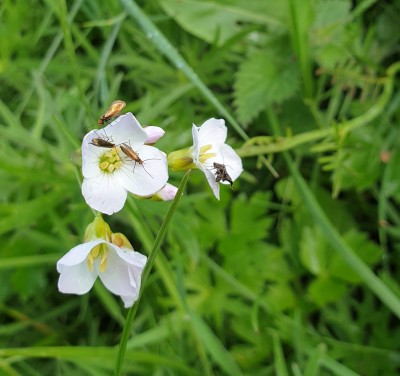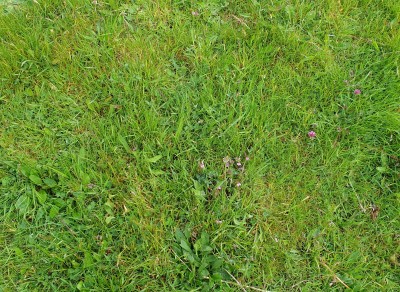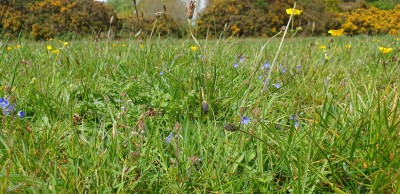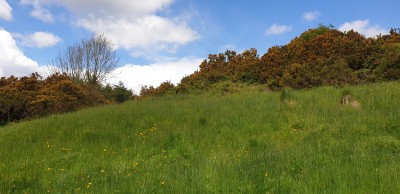Page 2 of 3
Re: IacobnDG
Posted: Fri Jul 03, 2020 5:03 pm
by Wurzel
A cracking set of 'Not quite as Common' Blues IocobnDG


It's really interestinG to read reports from an area that's relatively under-reported on UKB

Have a goodun and stay safe
Wurzel
Re: IacobnDG
Posted: Fri Jul 03, 2020 7:43 pm
by David M
IacobnDG wrote: ↑Thu Jul 02, 2020 10:36 pm
Back on the subject of mariscolore, I have just realised that British Common Blue females have highly reduced orange lunules, whereas in our females these are bright and have a much more well-defined boundary....
That's what caught my eye when you posted those females earlier, Jake. I'm used to 'blue' females but the sheer size of the orange lunules was something I hadn't hitherto seen.
Re: IacobnDG
Posted: Mon Jul 06, 2020 6:59 pm
by IacobnDG
I visited a National Trust property (Rowallane) today with a relatively intact meadow to look for butterfly orchids. There was only this rather old individual as I left it a bit too late.
However, there were many butterflies, mostly ringlets and meadow browns.
I also saw this very orange meadow brown which almost looks like a gatekeeper.
Other than satyrinae there were many common blues.
The grassland here is clearly quite old with well established Dactylorhiza and Conopodium so I suspect there are some gems here in terms of both insects and flora.
Re: IacobnDG
Posted: Mon Jul 06, 2020 7:38 pm
by Wurzel
That is a cracking looking Meadow Brown IacobnDG


- they do seem to be becoming slightly more prevalent

Have a goodun and stay safe
Wurzel
Re: IacobnDG
Posted: Tue Jul 07, 2020 5:48 am
by David M
IacobnDG wrote: ↑Mon Jul 06, 2020 6:59 pm...I also saw this very orange meadow brown which almost looks like a gatekeeper..
That's quite some beast, Jake, reminiscent of the Meadow Browns in the SE of France, where even there they tend not to be quite so well marked as your example.
Re: IacobnDG
Posted: Tue Jul 07, 2020 11:27 am
by IacobnDG
David M wrote: ↑Tue Jul 07, 2020 5:48 am
...reminiscent of the Meadow Browns in the SE of France...
I wonder if it's temperature dependent? Given that second gen adults always seem much more orange than first gen and we've had so much sun recently.
Re: IacobnDG
Posted: Tue Jul 07, 2020 5:31 pm
by David M
IacobnDG wrote: ↑Tue Jul 07, 2020 11:27 am..I wonder if it's temperature dependent? Given that second gen adults always seem much more orange than first gen and we've had so much sun recently.
Who knows, Jake? A sustained, short term period of high temperatures may well have an effect, although conditions in the south of France between June and August are routinely 30c+ and that level of warmth is a rarity anywhere in the UK and, of course, even more so in NI.
Re: IacobnDG
Posted: Tue Jul 07, 2020 6:11 pm
by Neil Freeman
IacobnDG wrote: ↑Mon Jul 06, 2020 6:59 pm
I also saw this very orange meadow brown which almost looks like a gatekeeper.
I have been seeing more and more female Meadow Browns with extra orange patches over the past few years but that one is a beauty, one of the best examples I have seen


IacobnDG wrote: ↑Mon Jul 06, 2020 6:59 pm
I wonder if it's temperature dependent? Given that second gen adults always seem much more orange than first gen and we've had so much sun recently.
Meadow Browns only have one generation in the UK, albeit a protracted one. It could still be related to climate change though.
Cheers,
Neil.
Re: IacobnDG
Posted: Wed Jul 08, 2020 5:24 pm
by IacobnDG
Thank you all for your expertise. I wonder have you read that paper on temperature and pigmentation in P. icarus? It makes for an interesting read and similar studies could reveal a lot about other species, I think.
Re: IacobnDG
Posted: Wed Jul 08, 2020 5:42 pm
by IacobnDG
I was in the field today but it ended up being quite dark and showery so there weren't many butterflies out.
I found a lot of Noctua pronuba which is interesting as we didn't use to have this species so it must be a recent colonisation.
I did some scything to open up the sward where some dog violets grow and I also found a ruby tiger caterpillar.
Re: IacobnDG
Posted: Thu Aug 13, 2020 12:51 pm
by IacobnDG
I was in the field once again yesterday, and the second generation of both
Lycaena phlaeas and
Polyommatus icarus is in full swing. It seems this year that all of our females conform more or less to Kane's desciption of "var. ceronus of icarus", although in the past there have been browner examples.
Our field now seems to filled with absolutely exceptional specimens as you can see.
The male below is ab. nigro-ocellata which is interesting as I have gotten this form before from eggs collected from this site. Unfortunately I coudn't get a better photo as they were very jumpy in the sun.
The
phlaeas also were hard to photograph but I got a nice photo of this ab. caeruleopunctata.
Overall I'm pretty happy with how the populations of these two species are doing at this site. The foodplants of both continue to spread and with continued careful management both species will continue to increase. One thing to note is that this summer has been quite warm so anecdotally I don't think the blue scales on the females are entirely decided by temperature and length of pupation, which was shown to be a factor in Hungarian
icarus females which are normally brown (Kertész, K., Piszter, G., Horváth, Z.E. et al. Changes in structural and pigmentary colours in response to cold stress in Polyommatus icarus butterflies. Sci Rep 7, 1118 (2017).
https://doi.org/10.1038/s41598-017-01273-7). In our population genetics is certainly a factor to some extent, and it would be good to see more research into this in the future.
Re: IacobnDG
Posted: Fri Aug 14, 2020 6:50 pm
by Wurzel
Interesting sightings IacobnDG - there's no trouble differentiating between female Brown Argus and those female Common Blues


Interesting to see the black spotted aberrant - that's reminiscent with the southern form of Common Blue, P.celina

Have a goodun and stay safe
Wurzel
Re: IacobnDG
Posted: Sat Aug 15, 2020 7:29 am
by David M
IacobnDG wrote: ↑Thu Aug 13, 2020 12:51 pm...Our field now seems to filled with absolutely exceptional specimens as you can see.
Absolutely. In fact, that first image is possibly the most beautiful example of a female
icarus I've seen. The orange lunules are amazing.

Re: IacobnDG
Posted: Sat Aug 15, 2020 2:28 pm
by Allan.W.
Totally agree with Davids comments ....................Stunning ! nice find ,love the female Common Blues ,but that one is quite exceptional ! Regards Allan.W.
Re: IacobnDG
Posted: Sat Aug 15, 2020 3:12 pm
by bugboy
As everyone else has said, that first female is simply stunning. Over here the bluer the female gets the smaller the lunules become but that one seems to have gone the other way!
Re: IacobnDG
Posted: Sat Apr 03, 2021 6:16 pm
by IacobnDG
Back in the field today, everything is just starting to come to life. My experiment scything the grass for the violets seems to have been successful and there are plants in flower further from the hedge than ever before (more than 2m). My dream is to one day have dark green fritillaries but this seems unlikely!
There were a lot of what seem to be mining bees on the blackthorn and I saw some interesting mating behaviour.
There is very little yet in terms of butterflies apart from a few tortoiseshells. I heard from a neighbour that there was a holly blue on a tree nearby but unfortunately I couldn't spot it.
It's very early yet but I know this year is going to be very interesting.
Re: IacobnDG
Posted: Tue May 25, 2021 6:54 pm
by IacobnDG
I was in Lagan Meadows yesterday and saw my first Cryptic Wood White of the year!
The weather was mixed and I was a bit too early to see courtship behaviour like I did last year. Micropterix calthella was out in abundance on Ranunculus and Cardamine flowers.

- Micropterix calthella on Cardamine
This is a very rich site grazed by cattle in the winter, with a good mix of scrub, damp and dry grassland; this is exceptional anywhere in this part of the world, never mind in suburban Belfast! It really is a special place.

- wetter turf with Pedicularis, Succisa etc

- drier turf with Veronica
I saw one Orange-Tip but couldn't get very close. There was an abundance of commoner white species, and it was sometimes hard to know which ones to follow, but Leptidea have a very weak and dainty flight that is unmistakable when you see it.

- good quality juvernica habitat: a mix of scrub and damp grassland with bush vetch, Cardamine and the main foodplant, meadow vetchling
I'll be back plenty over the next few weeks to try and catch the courtship rituals. I made this video with footage from last year:
https://youtu.be/N_0K4bzqarA
Re: IacobnDG
Posted: Tue May 25, 2021 6:57 pm
by Wurzel
Brilliant sightings and images IacobnDG

A species I'd love to see


Have a goodun and stay safe
Wurzel
Re: IacobnDG
Posted: Wed May 26, 2021 7:35 am
by David M
Thanks for those images, Jake. Not often we get to see
juvernica on here.

Those meadows do indeed look superb.
Re: IacobnDG
Posted: Fri Jun 04, 2021 11:58 pm
by IacobnDG
Back at Lagan Meadows. I saw more Cryptic Wood Whites than last time, and I got some good photos of mating behaviour.
I also saw some nice damselflies and a Silver Y.

 It's really interestinG to read reports from an area that's relatively under-reported on UKB
It's really interestinG to read reports from an area that's relatively under-reported on UKB 